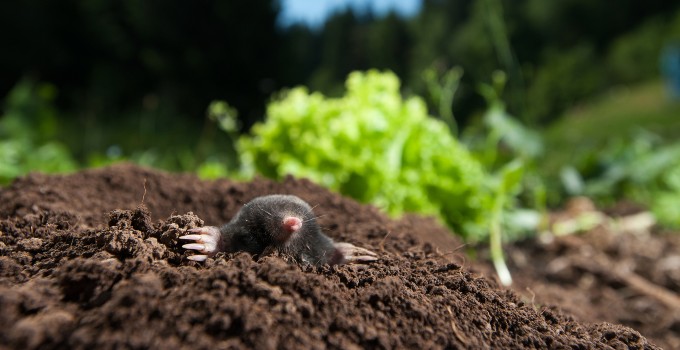
Your lawn is one of the most important aspects of your home to both you and your guests. It’s the first thing you see as you pull into your driveway at the end of a long day, and what your neighbors observe each time they drive by your house. In Lawrence, moles and voles can become frustrating as they damage your lawn and garden and make a home out of your landscaping.
What is a mole?
A mole is a small mammal that lives most of its life in a series of intricate underground tunnels. They are insectivores, which means they like to eat worms and insects, but will also settle for plant roots and bulbs. Since moles spend their entire lives underground, their eyes and ears are tiny and underdeveloped. Their cylindrical bodies can grow up eight inches long and have brown to dark grey fur. They have long snouts, but their most noteworthy feature is their large front feet. They are paddle-shaped with large claws to assist in their digging.
What attracts moles to my yard?
Moles are attracted to well-kept lawns. Shorter grass and softer soil allow them easier access for digging and prey. Moist soil is full of earthworms, which is their favorite food. Moles are always active, working, and eating no matter the time of day or year, although they do not forage as much during colder months. Moles typically keep to their tunnels year-round except for breeding season, which occurs between February and May. When digging tunnels, moles usually follow human-made structures like fence lines and building foundations. These are the first locations you should check for signs of an infestation.
What is a vole?
Voles are smaller counterparts to moles but can be identified through their many differences. Voles are rodents, and moles are mammals. Voles are herbivorous, meaning they eat a variety of grasses, plants, and bulbs. In winter, when there isn’t much vegetation, they tend to stick to tree bark or roots, and store seeds underground. Voles are slightly smaller than moles and have a short, stout body. They have similar coloring to moles but have fully developed ears and eyes. They are commonly mistaken for house mice but spend the entirety of their lives outdoors.
What attracts voles to my yard?
Voles gravitate towards vast, open properties. They prefer to burrow in places with lots of vegetation for them to feed on. Unlike moles, voles breed year-round in large numbers. At times, voles will take over hunting tunnels left behind by moles and use these to raise their young. They also create “surface runways” above-ground to allow for faster travel through the grass.
How can I tell if there are moles or voles in my yard?
It can be very stressful when you notice the first signs of an infestation of either moles or voles. These signs can include:
- Holes and mounds in your lawn
- Uprooted plants and vegetables
- Dents in your grass that look like connected pathways or runways
- Irregular gnaw marks on stems
You probably won’t see moles or voles moving around your yard. The best way to spot an infestation is to look for signs of tunneling.
Are moles and voles dangerous?
Moles and voles are not directly dangerous to humans. Moles pose more of a threat through the damage they can cause to your lawn. They constantly work, creating holes and tunnels that can cause you, your guests, or pets to trip or fall when walking through the grass. The garden that you’ve worked so hard on all year can also fall victim to mole and vole consumption. Although moles and voles have strong, specialized teeth, it’s not likely that they will bite you or even get near you for that matter. They move very quickly and will retreat back into their burrows if they feel threatened.
How can I prevent moles and voles from burrowing in my yard?
If you want to get rid of voles on your own, you need to create an environment that is not conducive to their survival. Use fencing specifically made to be mole or vole-proof, placing it at least one foot into the ground around trees and vegetable gardens. Remove debris like fallen leaves from your yard on a regular basis. They prefer areas protected by ground cover to feed, out of sight of predators. If you’re looking for a longer term solution, contact Schendel, your local wildlife company.
It’s challenging to prevent moles and voles from inhabiting your lawn. Since these pests live in intricate series of underground tunnels, getting their population under control is extremely difficult to do independently. The best course of action is contacting the professionals at Schendel at the first signs of an infestation. Call us today or fill out the contact form on this page for a free, no-obligation inspection.
What’s the Difference Between Moles and Voles in Lawrence in Kansas, Missouri and Arizona?
Serving Kansas, Missouri and Arizona






